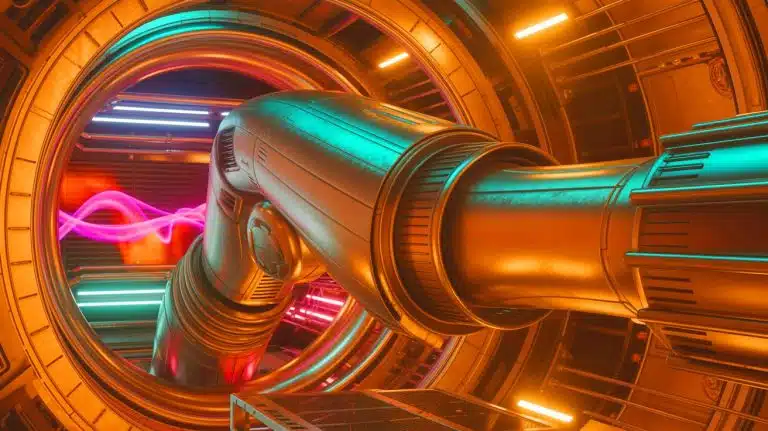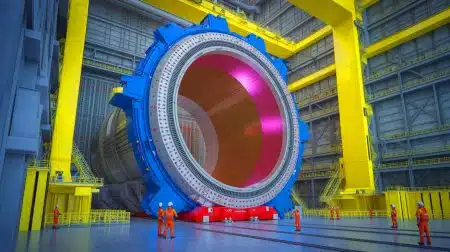| IN A NUTSHELL |
|
China is making notable strides in the realm of nuclear fusion technology with its recent development and testing of a sophisticated robotic arm system. Designed to aid maintenance in future fusion reactors, this system signifies a substantial leap toward realizing the country’s ambitious “artificial sun” project. The robotic arm system’s capability to lift 60 tons with high precision showcases the technological advancements achieved by Chinese scientists and engineers. This innovation is not just a technological marvel but also a testament to China’s commitment to leading in the global race for sustainable and clean energy solutions.
Precision and Power: A Technological Marvel
The newly developed robotic system in China stands out not only for its sheer power but also for its remarkable precision. During rigorous testing phases, the main arm demonstrated a vertical lifting accuracy of 3 to 4 millimeters. Meanwhile, the two smaller arms impressed with their ability to return to their exact starting positions with an accuracy of ±0.01 millimeters. This combination of strength and precision makes the system the most advanced remote-handling technology in the fusion field today.
Such precision is crucial in the maintenance of fusion reactors. Within these reactors, components like the cladding and divertor are constantly exposed to extreme conditions, including high temperatures and strong radiation. Regular maintenance under such conditions is a necessity, and the use of robotic systems ensures that these tasks can be performed safely and accurately. The system’s ability to handle heavy loads far surpasses that of similar technologies, such as Japan’s Mitsubishi Heavy Industries’ robotic arms, which can only manage a maximum tip load of two tons.
Expanding Horizons: Applications Beyond Fusion
Beyond its primary function in fusion reactors, the robotic arm system holds promise for a wide range of applications. According to Pan Hongtao, a researcher involved in the project, the technologies developed during this project have potential uses in the operation of next-generation nuclear fusion devices, both within China and internationally. The system's capabilities could extend to fields such as nuclear plant inspections, aerospace development, and even emergency rescue missions.
The project, known as the Comprehensive Research Facility for Fusion Technology (CRAFT), involves the efforts of over 300 scientists and engineers. The expertise gained through the development of this robotic system will likely benefit other fusion projects, such as the Burning Plasma Experimental Superconducting Tokamak in Hefei and the International Thermonuclear Experimental Reactor in France. These advances underscore the importance of international collaboration in the pursuit of clean and sustainable energy solutions.
China's Fusion Ambitions: The Road Ahead
China's ambitions in the field of nuclear fusion are underscored by the success of its experimental reactor, EAST, often referred to as the "artificial sun." Since 2006, EAST has achieved significant milestones in the quest for clean fusion energy, setting a world record at the Hefei Comprehensive National Science Center. The development of the robotic arm system marks another step forward in this journey, bringing China closer to achieving its long-term goal of sustainable fusion energy.
The CRAFT project, nicknamed Kuafu after a mythical figure known for chasing the sun, complements EAST by providing the necessary tools to maintain and operate future fusion reactors. This synergy between various projects highlights China's strategic approach to advancing its capabilities in nuclear fusion technology. As these projects progress, the potential for limitless, clean energy becomes increasingly attainable, promising a significant impact on global energy sustainability.
The Global Impact of Fusion Technology
The development of sophisticated technologies like China's robotic arm system represents a pivotal moment in the global pursuit of nuclear fusion energy. Fusion holds the promise of providing a virtually limitless source of clean energy, crucial for addressing the world's growing energy needs and combating climate change. As countries around the world invest in fusion research, the collaborative efforts seen in projects like the International Thermonuclear Experimental Reactor in France underscore the importance of shared knowledge and resources.
China's contributions to this field not only advance its own energy goals but also provide valuable insights and technologies that can benefit international fusion projects. The global scientific community eagerly anticipates the outcomes of these endeavors, which could revolutionize the way we produce and consume energy.
As China continues to push the boundaries of nuclear fusion technology, the world watches closely. The potential of fusion energy is enormous, promising an era of clean, sustainable power. However, significant challenges remain in achieving practical and economic viability. The question remains: how will global collaboration and innovation shape the future of fusion energy, and what role will China play in this transformative journey?
Did you like it? 4.5/5 (24)








Wow, China’s really stepping up their game with this robotic arm! 🚀
Wow, 60 tons?! That’s mind-blowing! 🤯
Is it just me, or does this sound like something out of a sci-fi movie? 🤖
Is this technology safe for widespread use in nuclear plants?
Are there any environmental concerns associated with this technology?
How long did it take China to develop this robotic arm system?
China is leading the way in fusion technology. Impressive! 🇨🇳
This is impressive, but will it be cost-effective for widespread use?
Thank you for the detailed article! It’s great to see innovation in clean energy. 🌍
60 tons is cool and all, but can it make me a cup of coffee? ☕️😂
60 tons is a lot, but can it lift my Monday mood? 😂
What are the potential risks of using such powerful technology in nuclear plants?
Interesting! How does this compare to similar technologies in the US?
Does this mean China is ahead of other countries in fusion technology?
Is there any international collaboration on this project, or is it purely a Chinese endeavor?
How precise can it be under extreme conditions like radiation or heat?
Can we expect similar advancements in other countries soon?
The precision is mind-blowing! How do they achieve such accuracy?